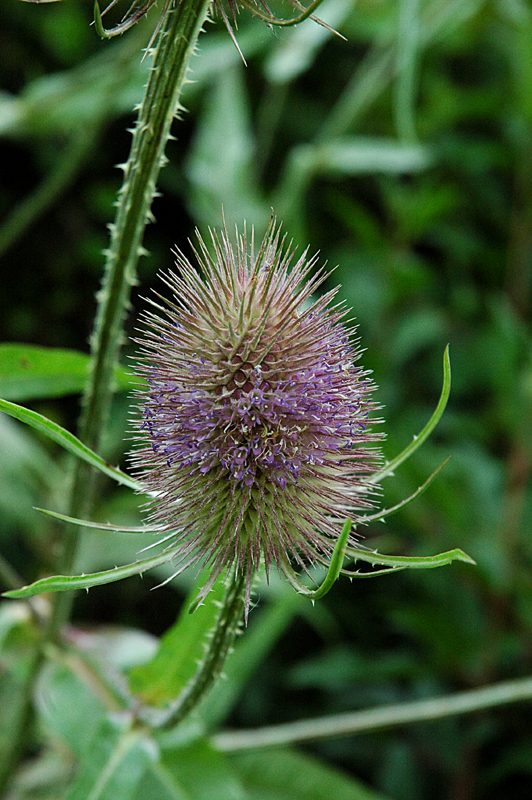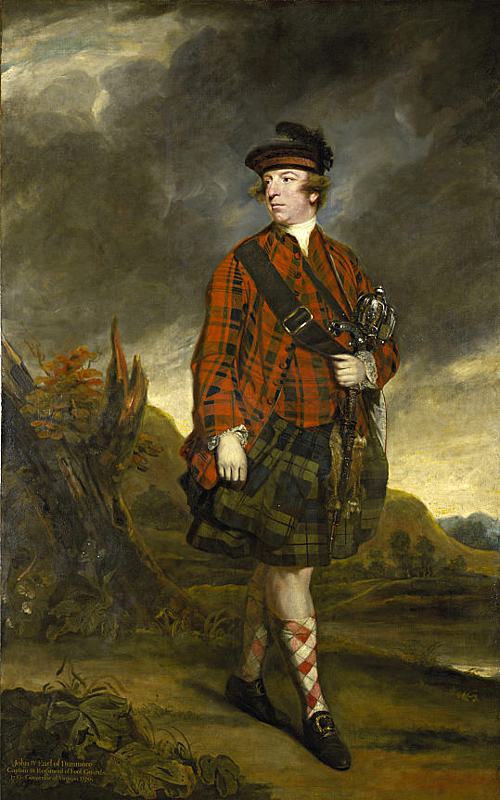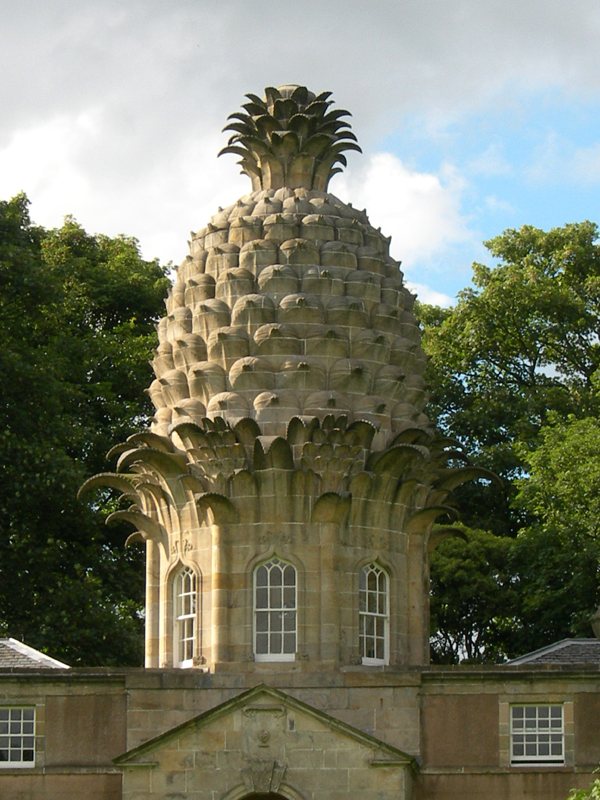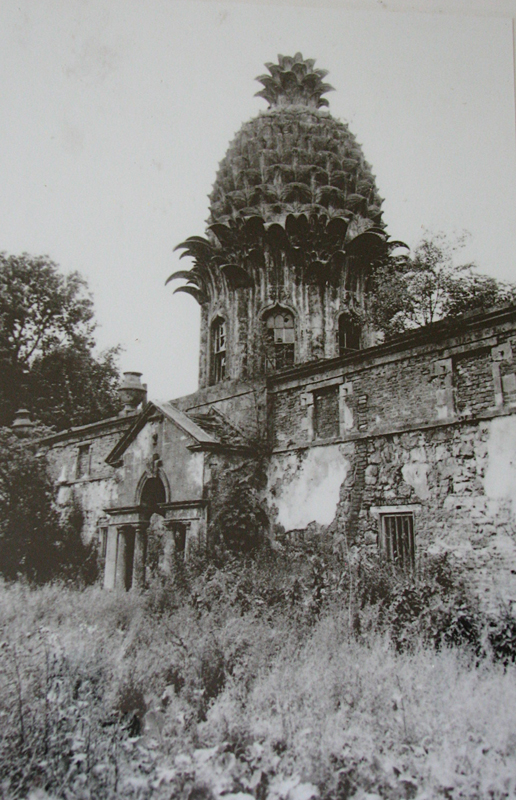Hi everybody,
This incredible architectural “folly”, in the shape of a pineapple, was one of our big “coups de coeur” in Scotland.
The Dunmore Pineapple is situated about one kilometre northwest of Airth and the same distance south of Dunmore in the Falkirk council area. We visited it on 25 July 2007. We were then based in Edinburgh campsite, a nice green place from which we could easily tour in and around the beautiful Scottish capital. That summer day was full of promises, the weather was not so bad and we had planned to visit a number of very interesting places, some of them listed on our Historic Scotland Explorer and National Trust passes. Next time we go to Scotland we’ll have to buy only one pass for “The National Trust for Scotland has joined forces with Historic Scotland and nine Discovering Distilleries sites to create the Scottish Heritage Pass.” GREAT! I hope we’ll still be able to have our “passports” stamped with beautiful pictures of the places visited as we used to in our previous trips. We love collecting them. 😉
So, in that beautiful summer day we intended to visit not less than Linlithgow Palace (HS), Blackness Castle (HS), Dunmore Pineapple (NTS and Landmark Trust) and last but not least the famous ‘Falkirk Wheel’.
Let us enter the magnificent Dunmore Park now. We happened to be alone on the site when we visited it at about 17:30 but then we could only visit the exterior of the Pineapple and the gardens. It was a feast and we came back with unforgettable memories of this garden of Eden!
The Dunmore Pineapple is an extraordinary architectural folly standing amidst wonderful walled gardens. As you linger there, along the colourful mixed borders, admiring the architectural “prouesse” of the building you feel as if walking on a thick green carpet!
In July there are many flowers in bloom growing along the old red brick walls. We looked with amazement at the great diversity of colourful flowers: climbing roses, white, pink, mauve poppies, prickly emblematic thistles, passion fruit flowers, sweet peas, daisies, cornflowers. Don’t forget your pocket flower guide when you go there, nor your camera of course!
The strange passion fruit flower…
A delicate shade of pink for this nice crinkly poppy…
A beautiful specimen of ‘Dipsacus fullonum’.
In English: Fuller’s teasel’ or ‘wild teasel’ . This plant was formerly widely used in textile processing, providing a natural comb for cleaning, aligning and raising the nap on fabrics, particularly wool.
In French : ‘cardère à foulon’.
In Aubigny-sur-Nère, the French ‘City of the Stuarts’ one street is called ‘rue des Foulons’. A funnier name is ‘cabaret des oiseaux’ : food and drink for birds there
On the French Republican Calendar: 17 Fructidor (3 September) is dedicated to ‘cardère’.
And still another beautiful colour for our beloved poppies but we didn’t see our favourite blue poppies here.
Built in 1761, for John Murray, the 4th Earl of Dunmore, by an unknown architect though some people attribute it to Sir William Chambers, a Scottish architect, this stunning “folly” was offered by John Murray to his wife Charlotte, as a birthday present. That was certainly a priceless and unique present to offer! From the windows of this two-storey garden house the lady had a view onto Dunmore Park, the family estate.
John Murray, 4th Earl of Dunmore (1730 –1809), generally known as Lord Dunmore, was a Scottish peer and colonial governor in the American colonies.Murray was named governor of the Province of New York in 1770, of Virginia the following year and of the Bahama Islands from 1787 to 1796. Dunmore was the last royal governor of Virginia.
Murray was born in Tymouth, Scotland. He was the eldest son of William Murray, 3rd Earl of Dunmore, and his wife, Catherine (née Murray); he was a nephew of John Murray, 2nd Earl of Dunmore. In 1745 William Murray and son, John (then only 15), joined the ill-fated campaign of “Bonnie Prince Charlie” (Charles Edward Stuart). Young Murray was appointed a page to Prince Charles. The second Earl, his uncle, remained with the Hanoverian regime.
After the Jacobite army was defeated at Culloden (1746), the Murray family was put under house arrest, and the patriarch, William, was imprisoned in the Tower. By 1750, William had received a conditional pardon. John was now 20, and joined the British Army. In 1756, after the deaths of his uncle and father, Murray became the fourth Earl of Dunmore.
Dunmore married Lady Charlotte, daughter of Alexander Stewart, 6th Earl of Galloway, in 1759. Their daughter, Lady Augusta Murray, was a daughter-in-law of King George III. The Dunmores had another daughter close to her age, Lady Catherine Murray, and soon after they landed in Virginia, they had another child, Lady Virginia Murray.
Source: Wikipedia
In the 18th century ornamental buildings called ‘follies’ such as neo-gothic buildings like Abbotsford, classical temples like Edinburgh’s “Parthenon” or Oban’s “colyseum”, flourished everywhere but the Dunmore Pineapple is quite unique even if the growing of pineapples in greenhouses and the use of the motif of this exotic fruit in architecture was very fashionable since the introduction of the pineapple in Britain, at the time of Charles II.
Dunmore Park, the ancestral home of the Earls of Dunmore, includes a large country mansion, Dunmore House,and grounds which contain, among other things, two large walled gardens. Walled gardens were a necessity for any great house in a northern climate in the eighteenth and nineteenth century, as a high wall of stone or brick helped to shelter the garden from wind and frost, and could create a microclimate in which the ambient temperature could be raised several degrees above that of the surrounding landscape. This allowed the cultivation of fruits and vegetables, and also of ornamental plants, which could not otherwise survive that far north.
The larger of the two gardens covers about six acres, located on a gentle south-facing slope. South-facing slopes are the ideal spot for walled gardens and for the cultivation of frost-sensitive plants. Along the north edge of the garden, the slope had probably originally been more steep. To allow both the upper and lower parts of the garden to be flat and level at different heights, it was necessary to bank up the earth on the higher northern side (away from the main house), behind a retaining wall about 16 feet high, and a solid 3 feet, 3 inches thick, which runs the entire length of the north side of the garden.
Walled gardens sometimes included one hollow, or double, wall which contained furnaces, openings along the side facing the garden to allow heat to escape into the garden, and chimneys or flues to draw the smoke upwards. This particularly benefited fruit trees or grape vines that could, if grown within a few feet of a heated, south-facing wall, be grown even further north than the microclimate created by a walled garden would normally allow.
A building containing a hothouse was built into this wall in 1761 by John Murray, 4th Earl of Dunmore. The hothouse, which was located in the ground floor of the building, was used, among other things, for growing pineapples. The south-facing ground floor, which is now covered in stucco and largely overgrown with vines, was originally covered with glass windowpanes. Additional heat was provided by a furnace-driven heating system that circulated hot air through cavities in the wall construction of the adjoining hothouse buildings. The smoke from the furnace was expelled through four chimneys, cleverly disguised as Grecian urns. The upper floor, which is at ground level when approached from the raised northern lawn, contained two small cottage-like apartments, or “bothies”, for the gardeners.
Murray left Scotland after the initial structure had been built, and went on to become Colonial Governor of Virginia in America. The upper-floor pavilion or summerhouse with its pineapple-shaped cupola and the Palladian lower-floor portico on the south side were added after Murray’s return from Virginia.
http://en.wikipedia.org/wiki/Dunmore_Pineapple
‘By 1970 the garden had become overgrown and, although the stonework of the Pineapple was intact, adjacent buildings were in danger of collapse. In 1974 the Countess of Perth gifted the building, together with its gardens and policies to the National Trust for Scotland. Acceptance was made possible by the cooperation of Landmark Trust which restored the buildings. These are now leased throughout the year for holiday accommodation.’
Through the Italian style portico entrance one can catch a glimpse of the orchard which has been planted with crab-apple trees.
The atmosphere of this magnificent garden was so peaceful that we would have liked to stay longer there. Indeed, it’s quite possible to spend a holiday in this magical place for ‘The Pineapple presides over an immense walled garden open to visitors, while at the back is a private garden for those staying, with steps leading into the elegant room inside The Pineapple itself.’
http://www.landmarktrust.org.uk/search-and-book/properties/pineapple-10726/
Being the only visitors that day we felt we were entering into a secret garden…
Don’t miss this enchanting place if you happen to be travelling in the area.
Bonne lecture!
.
A bientôt. Mairiuna.


















Leave a Reply